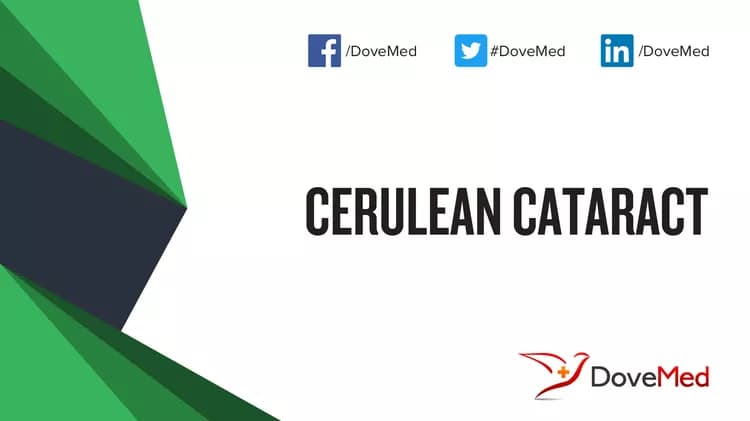What are the other Names for this Condition? (Also known as/Synonyms)
- CCA1 (Congenital Cataract, Cerulean Type 1)
- Congenital Cataract, Blue Dot Type 1
- Congenital Cataract, Cerulean Type 1
What is Cerulean Cataract? (Definition/Background Information)
- Cerulean Cataracts are opaque areas that develop in the lens of the eye that often have a bluish or whitish color. They may be present at birth or develop in very early childhood, but may not be diagnosed until adulthood. They are usually bilateral and progressive
- Infants can be asymptomatic, but may also be visually impaired from birth and develop nystagmus and amblyopia. In adulthood, the cataracts may progress, making lens removal necessary
- Cerulean Cataracts may be caused by mutations in several genes, including the CRYBB2, CRYGD, and MAF genes, and are inherited in an autosomal dominant manner
- No treatment is known to prevent Cerulean Cataracts, but frequent evaluations and cataract surgery are typically required to prevent amblyopia as the opacities progress
(Source: Cerulean Cataract; Genetic and Rare Diseases Information Center (GARD) of National Center for Advancing Translational Sciences (NCATS), USA.)
Who gets Cerulean Cataract? (Age and Sex Distribution)
- Cerulean Cataract is a rare congenital disorder. The presentation of symptoms may occur at birth or early childhood
- Both males and females may be affected
- Worldwide, individuals of all racial and ethnic groups may be affected
What are the Risk Factors for Cerulean Cataract? (Predisposing Factors)
- A positive family history may be an important risk factor, since Cerulean Cataract can be inherited
- Currently, no other risk factors have been clearly identified for the disorder
It is important to note that having a risk factor does not mean that one will get the condition. A risk factor increases one’s chances of getting a condition compared to an individual without the risk factors. Some risk factors are more important than others.
Also, not having a risk factor does not mean that an individual will not get the condition. It is always important to discuss the effect of risk factors with your healthcare provider.
What are the Causes of Cerulean Cataract? (Etiology)
- Cerulean Cataracts may be caused by mutations in several genes, including the CRYBB2, CRYGD, and MAF genes
- The condition is inherited in an autosomal dominant manner
(Source: Cerulean Cataract; Genetic and Rare Diseases Information Center (GARD) of National Center for Advancing Translational Sciences (NCATS), USA.)
Autosomal dominant pattern of inheritance: Autosomal dominant conditions are traits or disorders that are present when only one copy of the mutation is inherited on a non-sex chromosome. In these types of conditions, the individual has one normal copy and one mutant copy of the gene. The abnormal gene dominates, masking the effects of the correctly function gene. If an individual has an autosomal dominant condition, the chance of passing the abnormal gene on to their offspring is 50%. Children, who do not inherit the abnormal gene, will not develop the condition or pass it on to their offspring.
What are the Signs and Symptoms of Cerulean Cataract?
The signs and symptoms of Cerulean Cataract may include:
- Cerulean cataract
- Macular hypoplasia
- Retinal detachment
- Congenital cataract
- Cortical pulverulent cataract
- Iris coloboma
- Microcornea
- Sutural cataract
(Source: Cerulean Cataract; Genetic and Rare Diseases Information Center (GARD) of National Center for Advancing Translational Sciences (NCATS), USA.)
How is Cerulean Cataract Diagnosed?
The diagnosis of Cerulan Cataracts is made on the basis of:
- Complete physical examination
- Thorough medical history evaluation
- Assessment of signs and symptoms
- Laboratory tests
- Eye and vision examinations
- Imaging studies
- Biopsy studies, if necessary
Many clinical conditions may have similar signs and symptoms. Your healthcare provider may perform additional tests to rule out other clinical conditions to arrive at a definitive diagnosis.
What are the possible Complications of Cerulean Cataract?
The complications of Cerulean Cataract may include:
- Progressive deterioration of vision
- Poor vision; interference with day-to-day activities
- Reduced quality of life
Complications may occur with or without treatment, and in some cases, due to treatment also.
How is Cerulean Cataract Treated?
There is currently no cure for Cerulean Cataracts. The treatment options may include:
- Eyeglasses
- Brighter lighting
- Anti-glare sunglasses, or magnifying lenses
However, if these measures do not help, surgery is often the only effective treatment
- Surgery involves removing the cloudy lens and replacing it with an artificial lens. Surgery is often considered when vision loss regularly interferes with everyday activities, such as driving, reading, or watching TV
(Source: Cerulean Cataract; Genetic and Rare Diseases Information Center (GARD) of National Center for Advancing Translational Sciences (NCATS), USA.)
How can Cerulean Cataract be Prevented?
Cerulean Cataract may not be preventable, since it is a genetic disorder.
- Genetic testing of the expecting parents (and related family members) and prenatal diagnosis (molecular testing of the fetus during pregnancy), if available, may help in understanding the risks better during pregnancy
- If there is a family history of the condition, then genetic counseling will help assess risks, before planning for a child
- Active research is currently being performed to explore the possibilities for treatment and prevention of inherited and acquired genetic disorders
- Regular vision tests at periodic intervals are highly recommended to prevent vision loss
What is the Prognosis of Cerulean Cataract? (Outcomes/Resolutions)
- The prognosis of Cerulean Cataract is dependent upon the severity of the signs and symptoms and associated complications, if any
- Individuals with mild conditions have better prognosis than those with severe symptoms and complications
- Typically, the prognosis may be assessed on a case-by-case basis
Additional and Relevant Useful Information for Cerulean Cataract:
The following DoveMed website link is a useful resource for additional information:
Related Articles
Test Your Knowledge
Asked by users
Related Centers
Related Specialties
Related Physicians
Related Procedures
Related Resources
Join DoveHubs
and connect with fellow professionals


0 Comments
Please log in to post a comment.